Products
- FM-200 / HFC-227ea
- Novec 1230
- Inert Gas
- Inergen - IG-541
- Argonite - IG-55
- Nitrogen - IG-100
- Argon - IG-01
- High Pressure Water Mist
- Kitchen Suppression System
- Panel Protection System
- CO2 Flooding System
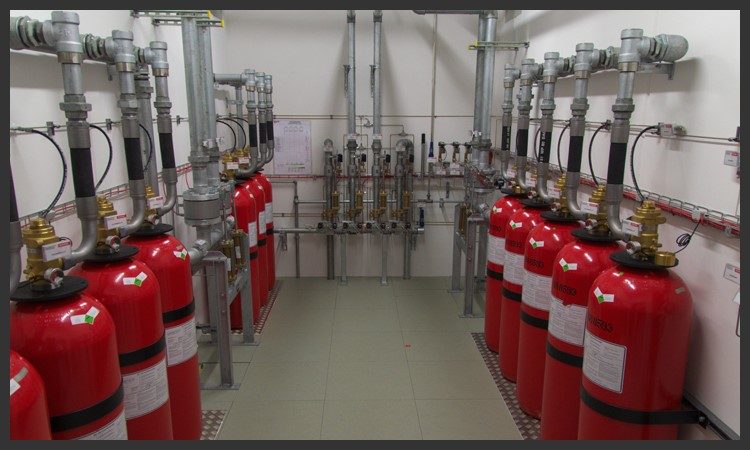
FM-200 belongs to the class of fluorinated hydrocarbons (HFCs) which are exclusively made up of carbon, fluoride and hydrogen atoms. The effect consists of cooling the flame and disrupting the chemical reaction of the combustion process. If exposed to flames, the FM-200 will emit small quantities of free radicals on the fire, which inhibit the chain reactions responsible for combustion. Another important aspect is that FM-200 is not harmful to sensitive devices. It is a clean, gaseous substance without particles or oily residue. It does not cause a significant reduction of the oxygen content and is therefore also suitable for human-occupied premises. After it has been activated, it can be extracted through simple ventilation

The extinguishing agent Novec 1230 (ISO-certification FK-5-1-12) is a colourless, almost odourless liquid which is contained in carbon, fluoride and oxygen molecules (chemical formula CF3CF2C(O)CF(CF3)2). It is fluorinated ketone (perfluorinated ethyl isopropyl ketone). The extinguishing effect of Novec 1230 in fixed fire extinguishing systems is due to a homogeneous inhibition (disruption of the combustion chain reaction).
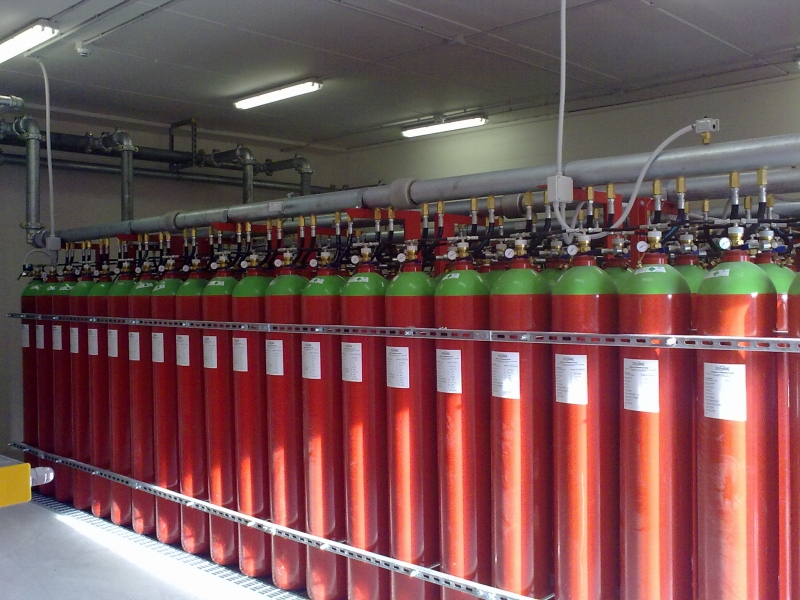
The extinguishing effect of inert gases such as argon, nitrogen and carbon dioxide is achieved through the displacement of atmospheric oxygen. This is known as the smothering effect and occurs if the necessary specific limit value for combustion is fallen short of. In most cases the fire will extinguish after a reduction of oxygen to approx. 13% volume. In order to improve the extinguishing properties, mixtures of the above-mentioned gases can also be used, for example, Inergen.

Inergen is the brand name for a mixture of 52% nitrogen, 40% argon and 8% carbon dioxide. The advantage of this mixture is the unique character of carbon dioxide (CO2). In the event of a lack of oxygen, it accelerates respiration so that the person in the room continues to have an oxygen supply. It is largely used in rooms, which are subject to specific safety regulations.

Argonite is a mixture of 50% nitrogen and 50% argon. The mixture of argon which is relatively dense compared to air, with the less-dense nitrogen leads to an optimal mixing throughout the extinguishing area. The use of this is mainly only effective in abnormally high rooms.

Nitrogen is a colourless, odourless and tasteless gas that is makes up 78.1% of the earth's atmosphere. Its density in relation to air is 0.967:1. As an extinguishing agent for fixed fire extinguishing systems, nitrogen is stored as a compressed gas in high-pressure steel cylinders. The maximum operating pressure is currently 300 bar. Nitrogen is not poisonous. However, here too when forming the necessary extinguishing concentration particularly in the event of a fire, risks may arise from the combustion gases and lack of oxygen.

Argon is an inert gas obtained from the ambient air that is stored as an extinguishing agent for fixed fire extinguishing systems as a compressed gas in high-pressure steel cylinders. The maximum operating pressure is currently 300 bar. Argon is not poisonous. However, when forming the necessary extinguishing concentration, particularly in the event of a fire, a risk may arise from the combustion gases and lack of oxygen. Argon makes up 0.93% of the earth's atmosphere.
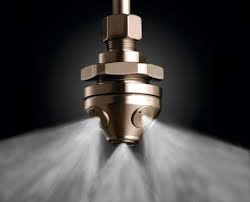
Water mist systems are a new technology in the development of automatic extinguishing systems. In contrast to conventional sprinkler systems, this system uses the extinguishing effect of very small droplets of water (water mist) Under high pressure extinguishing water is compressed through the stainless steel pipes to the extinguishing nozzles. Water mist is produced through the special design of the nozzles. The necessary pressure is generated through high-pressure pumps or alternatively through pressurised gas cylinders (nitrogen). The combination of an optimal droplet size and a dispersion of the droplets under high pressure, ensures a deep penetration of the water mist into the fire source and a rapid cooling of the flue gases. THE EXTINGUISHING EFFECT: - Cooling - Absorption (deflection of heat) - Inertisation (local oxygen displacement) The advantage of the misting systems in comparison to sprinkler systems is the low water consumption, that is, a lower water supply is necessary in comparison to a sprinkler system. The activation of this system therefore causes significantly less water damage.
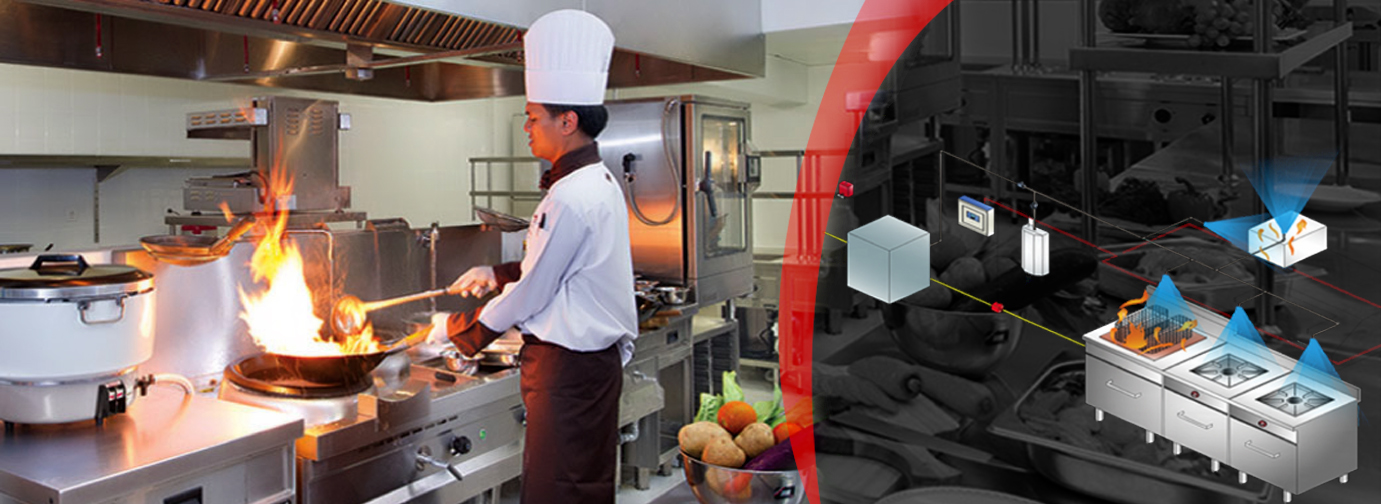
The Kitchen Fire Suppression System is an automatic pre-engineered system; designed to protect the kitchen area including the duct, fume hood and plenums, as well as all cooking appliances which use gas or electricity such as deep fat fryers, woks, griddles, salamanders, chain broilers and more.
This system caters to the needs of both small and large kitchens such as those in hotels, restaurants, hospitals and public institutions safeguarding guests, staff and property.
The system distributes the extinguishing agent over all protected areas, while interrupting the energy supply of gas and electricity for maximum protection against re-ignition.
After system operation, the kitchen can be ready to be re-utilized within minutes.
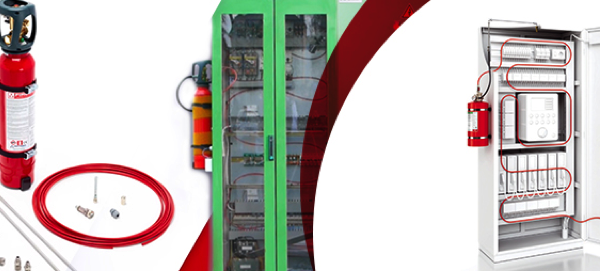 This fixed fire suppression system using heat sensitive pneumatic detection tubing, designed for the protection of small-unoccupied defined volume enclosures such as electrical switchgear cabinets and similar installations from small local flaming fire sources.
Product Concept:
This fixed fire suppression system using heat sensitive pneumatic detection tubing, designed for the protection of small-unoccupied defined volume enclosures such as electrical switchgear cabinets and similar installations from small local flaming fire sources.
Product Concept:
- The new kind of Fire Suppression System that installs directly inside individual high risk machinery or equipment-Closer to where a Fire could start
- Automatically detects & suppresses fire at the source
- Extinguishing agent is discharged through the burst hole in the sensor tube
- Useful for very small enclosed space and hard to reach area like electrical cabinets
- Ideal for multiple separated units

Carbon dioxide is primarily suitable for fighting fire classes B and C. In Fixed fire extinguishing systems, carbon dioxide is stored in a liquefied state in high-pressure steel cylinders. As carbon dioxide is harmful to health in high concentrations, occupational insurance companies prescribe particular protective measures in the event of an exceeding of a limit value of more than 5% volume. Carbon dioxide is primarily used as an extinguishing agent in electrical and electronic systems because, unlike all water-based extinguishing agents and the majority of powders, it is not electrically conductive. When designing the systems, attention must be paid to the fact that carbon dioxide is a respiratory poison.
Our Products
 FM-200 belongs to the class of fluorinated hydrocarbons (HFCs) which are exclusively made up of carbon, fluoride and hydrogen atoms. The effect consists of cooling the flame and disrupting the chemical reaction of the combustion process. If exposed to flames, the FM-200 will emit small quantities of free radicals on the fire, which inhibit the chain reactions responsible for combustion.
FM-200 belongs to the class of fluorinated hydrocarbons (HFCs) which are exclusively made up of carbon, fluoride and hydrogen atoms. The effect consists of cooling the flame and disrupting the chemical reaction of the combustion process. If exposed to flames, the FM-200 will emit small quantities of free radicals on the fire, which inhibit the chain reactions responsible for combustion.
Another important aspect is that FM-200 is not harmful to sensitive devices. It is a clean, gaseous substance without particles or oily residue. It does not cause a significant reduction of the oxygen content and is therefore also suitable for human-occupied premises. After it has been activated, it can be extracted through simple ventilation

The extinguishing agent Novec 1230 (ISO-certification FK-5-1-12) is a colourless, almost odourless liquid which is contained in carbon, fluoride and oxygen molecules (chemical formula CF3CF2C(O)CF(CF3)2). It is fluorinated ketone (perfluorinated ethyl isopropyl ketone). The extinguishing effect of Novec 1230 in fixed fire extinguishing systems is due to a homogeneous inhibition (disruption of the combustion chain reaction).

The extinguishing effect of inert gases such as argon, nitrogen and carbon dioxide is achieved through the displacement of atmospheric oxygen. This is known as the smothering effect and occurs if the necessary specific limit value for combustion is fallen short of. In most cases the fire will extinguish after a reduction of oxygen to approx. 13% volume.
In order to improve the extinguishing properties, mixtures of the above-mentioned gases can also be used, for example, Inergen.

Inergen is the brand name for a mixture of 52% nitrogen, 40% argon and 8% carbon dioxide. The advantage of this mixture is the unique character of carbon dioxide (CO2). In the event of a lack of oxygen, it accelerates respiration so that the person in the room continues to have an oxygen supply. It is largely used in rooms, which are subject to specific safety regulations.

Argonite is a mixture of 50% nitrogen and 50% argon. The mixture of argon which is relatively dense compared to air, with the less-dense nitrogen leads to an optimal mixing throughout the extinguishing area. The use of this is mainly only effective in abnormally high rooms.
This agent reduces the oxygen concentration to extinguish the fire, but to a percentage suitable for occupied areas. The 50-50 mixture of Argon and Nitrogen allows the perfect distribution of the agent in the room for effective extinguishing. It is highly recommended for class A, B and C hazards. The system operates by total flooding of the room, ensuring complete discharge in less than 1 minute.

Nitrogen is a colourless, odourless and tasteless gas that is makes up 78.1% of the earth’s atmosphere. Its density in relation to air is 0.967:1. As an extinguishing agent for fixed fire extinguishing systems, nitrogen is stored as a compressed gas in high-pressure steel cylinders. The maximum operating pressure is currently 300 bar.
Nitrogen is not poisonous. However, here too when forming the necessary extinguishing concentration particularly in the event of a fire, risks may arise from the combustion gases and lack of oxygen.

Argon is an inert gas obtained from the ambient air that is stored as an extinguishing agent for fixed fire extinguishing systems as a compressed gas in high-pressure steel cylinders. The maximum operating pressure is currently 300 bar. Argon is not poisonous. However, when forming the necessary extinguishing concentration, particularly in the event of a fire, a risk may arise from the combustion gases and lack of oxygen. Argon makes up 0.93% of the earth’s atmosphere.

Water mist systems are a new technology in the development of automatic extinguishing systems. In contrast to conventional sprinkler systems, this system uses the extinguishing effect of very small droplets of water (water mist)
Under high pressure extinguishing water is compressed through the stainless steel pipes to the extinguishing nozzles. Water mist is produced through the special design of the nozzles. The necessary pressure is generated through high-pressure pumps or alternatively through pressurised gas cylinders (nitrogen).
The combination of an optimal droplet size and a dispersion of the droplets under high pressure, ensures a deep penetration of the water mist into the fire source and a rapid cooling of the flue gases.
THE EXTINGUISHING EFFECT:
– Cooling
– Absorption (deflection of heat)
– Inertisation (local oxygen displacement)
The advantage of the misting systems in comparison to sprinkler systems is the low water consumption, that is, a lower water supply is necessary in comparison to a sprinkler system. The activation of this system therefore causes significantly less water damage.

The Kitchen Fire Suppression System is an automatic pre-engineered system; designed to protect the kitchen area including the duct, fume hood and plenums, as well as all cooking appliances which use gas or electricity such as deep fat fryers, woks, griddles, salamanders, chain broilers and more.
This system caters to the needs of both small and large kitchens such as those in hotels, restaurants, hospitals and public institutions safeguarding guests, staff and property.
The system distributes the extinguishing agent over all protected areas, while interrupting the energy supply of gas and electricity for maximum protection against re-ignition.
After system operation, the kitchen can be ready to be re-utilized within minutes.

This fixed fire suppression system using heat sensitive pneumatic detection tubing, designed for the protection of small-unoccupied defined volume enclosures such as electrical switchgear cabinets and similar installations from small local flaming fire sources. Product Concept:
- The new kind of Fire Suppression System that installs directly inside individual high risk machinery or equipment-Closer to where a Fire could start
- Automatically detects & suppresses fire at the source
- Extinguishing agent is discharged through the burst hole in the sensor tube
- Useful for very small enclosed space and hard to reach area like electrical cabinets
- Ideal for multiple separated units

Carbon dioxide is primarily suitable for fighting fire classes B and C.
In Fixed fire extinguishing systems, carbon dioxide is stored in a liquefied state in high-pressure steel cylinders.
As carbon dioxide is harmful to health in high concentrations, occupational insurance companies prescribe particular protective measures in the event of an exceeding of a limit value of more than 5% volume.
Carbon dioxide is primarily used as an extinguishing agent in electrical and electronic systems because, unlike all water-based extinguishing agents and the majority of powders, it is not electrically conductive. When designing the systems, attention must be paid to the fact that carbon dioxide is a respiratory poison.
